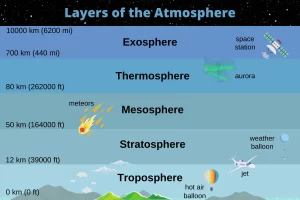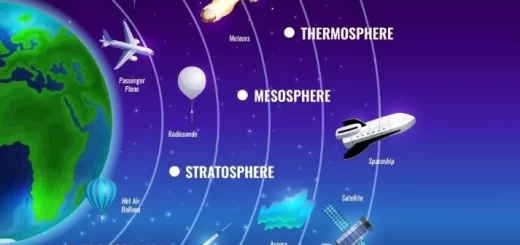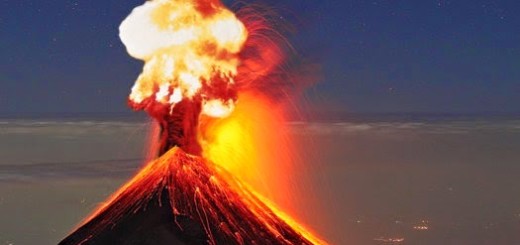Characteristics and Importance of the mesosphere layer, Is mesosphere the coldest layer?
The mesosphere layer is the third layer of the atmospheric envelope, It is the middle layer, It is the coldest one, The atmospheric pressure in the mesosphere layer decreases as we go up, until it becomes 0.01 mb, at its top.
The mesosphere layer
The mesosphere layer extends from the stratopause (at a height of 50 km above the sea level) to the mesopause (at a height of 85 km above the sea level). The thickness of the mesosphere layer is 35 kilometres.
The temperature in the mesosphere layer decreases with a rate as we go up until it reaches (- 90 degrees Celsius) at its top. So, it is called the coldest layer. The mesosphere layer contains limited quantities of helium and hydrogen gases only, So, It is highly rarefied.
Mesosphere layer protects the planet Earth from the celestial rocky masses that enter the atmospheric envelope of the Earth, where they burn as a result of their friction with the air molecules and forming luminous meteors.
Although the meteors are burnt in the mesosphere layer, the spaceships can not burn during their passing in it as their conical fronts disperse the heat and their tails are made of insulating material.
In the mesosphere layer, The temperature decreases with increasing height, due to decreasing absorption of solar radiation by the rarefied atmosphere and increasing cooling by CO2 radiative emission, the top of the mesosphere layer, called the mesopause, is the coldest part of Earth’s atmosphere, varying according to the latitude and the season.
The mesosphere, stratosphere and the lowest part of the thermosphere are collectively referred to as the middle atmosphere, which spans heights from approximately 10 kilometres to 100 kilometres.
The term near space is sometimes used, This term does not have a technical definition, but typically refers to the region of the atmosphere up to 100 km, roughly between the Armstrong limit (above which humans need a pressure suit to survive) up to the Kármán line where astrodynamics must take over from the aerodynamics to achieve flight.
Importance of the mesosphere layer
The mesosphere is the third layer of Earth’s atmosphere, located above the stratosphere and below the thermosphere, at altitudes of about 50 to 85 kilometers (31 to 53 miles). Though less studied than other atmospheric layers, it plays a vital role in Earth’s atmospheric system.
The mesosphere is where most meteors and space debris burn up upon entering Earth’s atmosphere. This prevents these objects from reaching the surface, making the mesosphere Earth’s first line of defense against potential meteor impacts.
The mesosphere is the coldest layer of Earth’s atmosphere, with temperatures dropping as low as −90°C (−130°F). This cold layer plays a role in the overall energy balance of Earth’s atmosphere and in how heat is distributed between the surface and space.
The mesosphere is where noctilucent clouds form. These rare, thin clouds are made of ice crystals and occur at very high altitudes, mainly near the poles during summer. They can reflect sunlight after sunset and before sunrise, creating a glowing sky.
The mesosphere is affected by atmospheric waves generated in the lower layers of the atmosphere. These waves can interact with the stratosphere and influence large-scale weather patterns, such as jet streams and planetary waves, which in turn affect Earth’s climate.
Some important chemical reactions occur in the mesosphere, including reactions involving ozone and water vapor. While the bulk of ozone resides in the stratosphere, reactions in the mesosphere help regulate the ozone layer’s balance and contribute to protecting life on Earth from harmful ultraviolet (UV) radiation.
The mesosphere is also a transition zone where space weather, like solar winds and cosmic rays, begins to affect the atmosphere. These interactions can create phenomena such as polar mesospheric clouds and can influence satellite communications and GPS signals.
The mesosphere provides a valuable region for studying how Earth’s atmosphere interacts with space. Understanding the mesosphere helps scientists study how energy from the sun and space weather affects Earth’s atmosphere and how it contributes to the overall stability of the planet’s climate system.
Though the mesosphere is not directly involved in everyday weather, its functions are crucial for protecting Earth from space hazards, regulating atmospheric processes, and supporting scientific research on space-atmosphere interactions.
You can follow science online on YouTube from this link: Science online
You can download Science Online application on Google Play from this link: Science online Apps on Google Play
Atmospheric layers and pressure, Troposphere, Stratosphere, Mesosphere and Thermosphere
The characteristics and the importance of the thermosphere layer
The characteristics and the importance of the troposphere layer
The characteristics and the importance of the stratosphere layer




